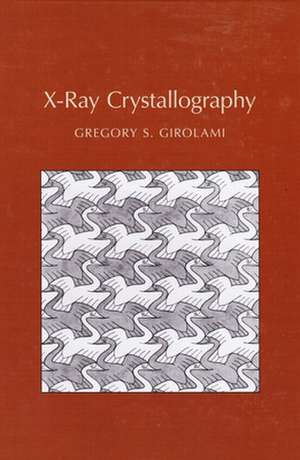X-Ray Crystallography
Autor Gregory S. Girolamien Limba Engleză Hardback – 31 iul 2015
Preț: 434.83 lei
Preț vechi: 536.74 lei
-19% Nou
Puncte Express: 652
Preț estimativ în valută:
83.21€ • 88.97$ • 69.37£
83.21€ • 88.97$ • 69.37£
Carte indisponibilă temporar
Doresc să fiu notificat când acest titlu va fi disponibil:
Se trimite...
Preluare comenzi: 021 569.72.76
Specificații
ISBN-13: 9781891389771
ISBN-10: 1891389777
Pagini: 300
Ilustrații: illustrations
Dimensiuni: 187 x 266 x 30 mm
Greutate: 1.04 kg
Editura: University Science Books,U.S.
Locul publicării:Sausalito, United States
ISBN-10: 1891389777
Pagini: 300
Ilustrații: illustrations
Dimensiuni: 187 x 266 x 30 mm
Greutate: 1.04 kg
Editura: University Science Books,U.S.
Locul publicării:Sausalito, United States
Descriere
This is a well-balanced, thorough, and clearly written introduction to the subject. It features excellent illustrations and homework problems throughout, making it invaluable as a textbook. The book progresses in a logical and clear fashion from the fundamentals through to advanced topics, such as disorder, twinning, microfocus sources, low energy electron diffraction, charge flipping, protein crystallography, the maximum likelihood method of refinement, and powder, neutron, and electron diffraction.
The author's clear writing style and distinctive approach is well suited for chemists, biologists, materials scientists, physicists, and scientists from related disciplines.
It is a great resource for those who are learning the subject for the first time (both advanced undergraduate and graduate students), and for those who have practical experience but seek a handy reference summary.
The author's clear writing style and distinctive approach is well suited for chemists, biologists, materials scientists, physicists, and scientists from related disciplines.
It is a great resource for those who are learning the subject for the first time (both advanced undergraduate and graduate students), and for those who have practical experience but seek a handy reference summary.
Cuprins
PART I: SYMMETRY AND SPACE GROUPS
Introduction
Point Symmetry Operations
Point Groups
Periodicity
Travel Symmetry Operations
One- and Two-Dimensional Lattices
Three-Dimensional Lattices
Two-Dimensional Plane Groups
Equivalent Positions
Three-Dimensional Space Groups, Part 1
Three-Dimensional Space Groups, Part 2
Three-Dimensional Space Groups, Part 3
PART II: X-RAYS AND DIFFRACTION
Generation of X-rays
Diffractometers and Data Collection
Scattering from a Single Electron
Scattering from Atoms
Diffraction from One-Dimensional Arrays
Diffraction from Two- and Three-Dimensional Arrays
Reciprocal Space and Miller Indices
Bragg's Law, Scattering Planes, and d-Spacings
The Limiting Sphere, Resolution, and Indexing
Reflection Intensities
Structure Factors and Argand Diagrams
Phases, Friedel's Law, and Laue classes
Centrosymmetry and Chirality
Reflection Conditions
Determining the Space Group of a Crystal
PART III: SOLVING AND REFINING CRYSTAL STRUCTURES
Fourier Transforms in Crystallography
Trial and Error Methods
Charge Flipping
The Patterson Method
The Heavy Atom Approximation
Protein Crystal Structures
Direct Methods, Part 1
Direct Methods, Part 2
Refining Crystal Structures
Occupancy, Displacement Parameters, and Disorder
Twinning
Examples of Twinned Crystals
Mistakes and Pitfalls
Powder X-ray Diffraction
Electron and Neutron Diffraction
Appendix A Vector Tutorial
Appendix B The Ewald Sphere
Appendix C Atomic Scattering Factors
Appendix D The Patterson Function
Appendix E Introduction to SHELX
Appendix F In-class Demonstration of Diffraction
Bibliography
Index
Introduction
Point Symmetry Operations
Point Groups
Periodicity
Travel Symmetry Operations
One- and Two-Dimensional Lattices
Three-Dimensional Lattices
Two-Dimensional Plane Groups
Equivalent Positions
Three-Dimensional Space Groups, Part 1
Three-Dimensional Space Groups, Part 2
Three-Dimensional Space Groups, Part 3
PART II: X-RAYS AND DIFFRACTION
Generation of X-rays
Diffractometers and Data Collection
Scattering from a Single Electron
Scattering from Atoms
Diffraction from One-Dimensional Arrays
Diffraction from Two- and Three-Dimensional Arrays
Reciprocal Space and Miller Indices
Bragg's Law, Scattering Planes, and d-Spacings
The Limiting Sphere, Resolution, and Indexing
Reflection Intensities
Structure Factors and Argand Diagrams
Phases, Friedel's Law, and Laue classes
Centrosymmetry and Chirality
Reflection Conditions
Determining the Space Group of a Crystal
PART III: SOLVING AND REFINING CRYSTAL STRUCTURES
Fourier Transforms in Crystallography
Trial and Error Methods
Charge Flipping
The Patterson Method
The Heavy Atom Approximation
Protein Crystal Structures
Direct Methods, Part 1
Direct Methods, Part 2
Refining Crystal Structures
Occupancy, Displacement Parameters, and Disorder
Twinning
Examples of Twinned Crystals
Mistakes and Pitfalls
Powder X-ray Diffraction
Electron and Neutron Diffraction
Appendix A Vector Tutorial
Appendix B The Ewald Sphere
Appendix C Atomic Scattering Factors
Appendix D The Patterson Function
Appendix E Introduction to SHELX
Appendix F In-class Demonstration of Diffraction
Bibliography
Index
Notă biografică
Gregory S. Girolami is Professor of Chemistry and Chemistry Department Head at the University of Illinois at Urbana-Champaign. He received B.S. degrees both in chemistry and in physics from the University of Texas at Austin, and his Ph.D. degree in 1981 from the University of California at Berkeley. Thereafter, he was a NATO postdoctoral fellow at Imperial College of Sciences and Technology in London, England, with Nobel Laureate Sir Geoffrey Wilkinson. He joined the faculty of the University of Illinois at Urbana-Champaign in 1983. His research emphasizes the synthesis of new inorganic and organometallic compounds and materials, investigations of their reactivity, and measurements and interpretations of their physical properties. As part of this work, he has extensively used X-ray crystallography, and has taught a course on this topic at the University of Illinois since 1997.
Caracteristici
A well-balanced and thorough introduction to this important and widely practiced technique
The author's writing style is clear and distinctive
This book is suitable for students learning the subject and professionals needing a reference guide
The author's writing style is clear and distinctive
This book is suitable for students learning the subject and professionals needing a reference guide
